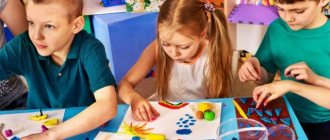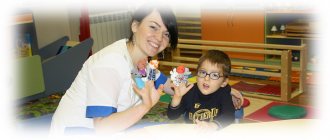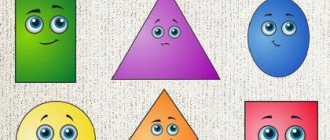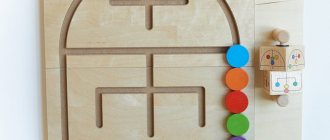No child comes into the world talking. The ability to learn speech is a natural human property, inherent from birth. The native language of the “little man” becomes the one spoken by those closest to him. Significant adults for the child are parents or legal representatives.
Senior preschool age is a period of formation of new mental qualities and improvement of processes of cognitive activity. “Perestroika” is taking place: children comprehend information about themselves and analyze the world around them. New opportunities also open up for the baby’s speech.
The period of changes has not spared the preschool education system. The Federal State Educational Standard has made its contribution. The changes affected educational activities and the level of professionalism of teachers and educators. The Federal State Educational Standard identifies 5 educational areas, speech development is one of them.
Speech development of children in older preschool age
Speech development is a designation of stages and techniques in a complex associated with mastering the means of speech, which are characterized by the development of verbal thinking, communication and creativity skills.
Speech is a dynamic phenomenon. Language does not stand still, but adapts to conditions and realities. Children feel these innovations better than us. The preschool stage is determined by intensive speech development. The children are making a leap in expanding their vocabulary. The speech became concrete and meaningful. At older preschool age, a child’s vocabulary already reaches 3-4 thousand words. During this period, children develop a “sense of language.” The young “linguist” intuitively senses the language norm. The child provides comments on the actions. Says: what am I doing now?
The growing needs of a preschooler act as a motive for language acquisition. The speech regulation function develops, which helps control activity and behavior. All activities are related to speech. The preschooler has new tasks and his social circle among peers and adults expands. It is important for a child to be understood by his interlocutors. The “little man” listens to people’s speech and copies the phrases and phrases he likes.
Observations play a role in vocabulary acquisition. The ability to see and feel the beauty of nature is formed during walks in the fresh air. Let them want to talk about the color of the clouds or the shape of the leaves on the trees! In the process of observation, children's vocabulary expands, and sentences acquire complex structures. .
Features of speech development of older preschoolers
A child of 5-7 years old monitors the pronunciation features of his peers and some errors in his own speech, and masters the sound analysis of words. It is not immediately possible without errors: sibilants are not pronounced clearly, in complex words syllables are rearranged, the letter “P” is not pronounced. A kindergartener's number of simple, common and complex sentences increases. Errors occur when changing words by case, especially when forming nouns in the genitive plural (“no gloves”). Teachers guide children in the correct use of grammatical forms. To understand how nouns are formed, let’s introduce children to the concept of a word-formation pair; Let's tell you how, with the help of the same suffix, words are formed that indicate a person (work-worker, gardener-gardener) or an object (rain-raincoat).
At this age, the child retells fairy tales or short stories, and comes up with a plot based on a series of paintings. Children are able to identify a topic and arrange parts of a text sequentially. With the help of adults, he selects words with the same root. The children form and use comparative adjectives in speech (strong - stronger; bright - brighter). They correctly understand and use prepositions without errors. Having heard an unfamiliar word, preschoolers often change it into one that is known. Mistakes occur, this is due to the identity of the roots: robber-rake.
Some children do not know how to use intonation or monitor the speed and volume of speech. In the senior group of kindergarten, a new type of work is introduced: children are introduced to the verbal composition of a sentence. Working on the intonation and expressiveness of speech will also help: we teach children to express their attitude to what is happening with their voice (raising and lowering their voices, placing logical stresses).
Art lesson on the topic “Border guard with a dog” in senior groups of preschool educational institutions
Dialogical speech is important for a child: he lives in society. Teachers are working to improve it. Here we include:
- Ability to listen and understand the interlocutor;
- Formulate questions;
- Build a replica based on the task at hand;
- Use the norms of speech etiquette (greetings, farewells).
Instill in children the ability to build a dialogue: ask, support, thank, answer, ask for forgiveness.
To do this, conversations are held on various topics that are related to life in the family and in kindergarten. The baby learns to listen to the interlocutor and ask questions. The skills that a child acquires during the construction of dialogic speech will also be useful in monologue. Parents often devote themselves to everyday work without reserve, so they do not pay due attention to the child’s speech development. The preschooler has a poor vocabulary.
Close cooperation between family and kindergarten is the path to correct speech and a rich vocabulary. It is important that you talk to your child at home: read books aloud, discuss the events of the day.
Norm of child speech development between the ages of 5 and 6 years
An older preschooler at this age makes almost no grammatical mistakes. Sometimes he may incorrectly place emphasis on unfamiliar words or use a noun in the wrong form. If adults point out mistakes made, then children in most cases do not repeat them. A child of the sixth year of life answers adults’ questions in detail and does so clearly and distinctly. He can compose a story based on a picture or a series of sequential pictures, come up with the beginning and ending of a story, a fairy tale or a short story.
Children of this age can speak louder and quieter, faster and slower, in a whisper. Reciting poems and fairy tales by heart, five-year-old children do it very artistically, selecting the right intonation, making timely stops provided by the author. They can choose words that are similar or opposite in meaning.
Children continue to classify words into groups: fir-tree, birch, aspen, pine - these are trees. Stork, swallow, rook, starling are birds. Cottage cheese, milk, cheese, kefir are dairy products. Children aged six years pronounce almost all sounds correctly.
In order to fully prepare for schooling, a child of five to six years old must be able to coherently express his thoughts and construct logical, complete statements. It is important to correct deficiencies in sound pronunciation in a timely manner, to teach children to use their voice and means of expression. If children receive a lot of positive information from the outside world and from fiction that they can discuss with adults, this greatly stimulates children's speech development.
DEVELOPMENT OF CHILD'S SPEECH FROM 6 TO 7 YEARS OLD
At six years old, children communicate freely with peers and adults. Well-developed speech by the age of seven will help the future first-grader successfully master the school curriculum.
At this age, intensive development of thinking occurs, which is closely related to the development of speech. A 6-year-old child vitally needs communication with an adult, when he can discuss everything that happens around him: objects, phenomena and relationships with people.
Diagnosis of speech development in children of senior preschool age
In the preschool period, shortcomings in the child’s speech development become obvious. Delay in speech development negatively affects the baby’s behavior and activities. Disturbances in the child’s speech development are identified during diagnostic testing. Corrective work begins with diagnosis.
When examining a child, they analyze: the development of sound analysis, phonemic hearing, the composition and richness of the vocabulary, communication skills, and the grammatical structure of speech.
Diagnosis of children is carried out on the basis of diagnostic methods for examining different aspects of the speech of preschool children, recommended by O.S. Ushakova, E.A. Strebeleva, E.M. Strunina. Based on the diagnostic results, the levels of children's speech development are revealed: high, average, below average, low. Levels of formation reflect a set of universal educational actions that a kindergartener acquires after mastering the educational program. Diagnosis is carried out according to several criteria.
- Vocabulary : richness of vocabulary; the ability to select words that denote the qualities of an object; understanding the characteristics and qualities of an object.
- Sound culture of speech : auditory attention; the ability to distinguish vowels and consonants; the ability to characterize sounds in a word; the ability to combine sounds into groups.
- Grammatical structure of speech : the ability to describe an object (a picture from a book or a toy); the ability to create a description without visualization, based on life experience; ability to write a story based on pictures; ability to retell according to a pattern.
Techniques for the development of coherent speech : speech patterns, questions, explanations, motivated assessment of children’s answers and actions, skit games.
The literature describes methods for studying the coherent speech of preschoolers. Children are given tasks at the reproductive and productive levels. In the first case, the preschooler is given a template to retell or repeat. In the second, we use a toy or a picture from a magazine. The child creates an independent statement. When teaching, it is permissible to use 2-4 toys: in stories about games and play actions, the coherence of children's statements increases. At the beginning of teaching storytelling, ready-made game situations are used, which are played out by an adult.
Speech development indicators | |
| Mastery of a dictionary | Activation of adjectives and verbs. The ability to select words that are accurate in meaning in a speech situation |
| The ability to select antonyms and synonyms for given words of different parts of speech | |
| Ability to understand and use different meanings of polysemantic words | |
| Ability to differentiate general concepts (wild and domestic animals, etc.) | |
| Grammar | Ability to form names of baby animals |
| Ability to select cognate words | |
| Ability to agree nouns and adjectives in gender and number | |
| Ability to form difficult forms of the genitive case (hares, foals, lambs) | |
| Ability to form difficult forms of the imperative and subjunctive mood (hide, dance, look) | |
| Ability to construct complex sentences of various types | |
| Phonetics | Ability to differentiate pairs of sounds s-z, s-ts, sh-zh, l-r |
| Ability to distinguish between hissing, whistling and sonorant sounds | |
| Ability to distinguish between hard and soft sounds | |
| The ability to change the strength of the voice, tempo of speech, voice strength, intonation depending on the content of the statement | |
| Ability to select words and phrases that sound similar | |
| Connected speech | In retelling literary works, the ability to convey the dialogue of the characters and the characteristics of the characters |
| Ability to write descriptions, narrations and reasoning | |
| The ability to develop a storyline in a series of paintings, connecting parts of a statement using different types of connections | |
| General indicators of children's speech development | |
Features of speech of six-year-old children
At this age, the level of children's speech is directly dependent on the speech culture of the adults who surround the preschooler. If the speech of close people is grammatically correct, it often contains vivid epithets, it is rich in content, if adults correct the child’s mistakes in a timely manner, we can say with complete confidence that the child’s speech will have similar qualities.
Lexicon
Children during this period have from three to five thousand words in their active vocabulary. You should not assume that older preschoolers use all this vocabulary in everyday speech; most often, their everyday vocabulary is somewhat more modest. Children do not attach the correct meaning to all words; there are also erroneous interpretations of meanings. Sometimes their speech is clogged with colloquial or slang expressions and phrases.
We must strive to ensure that six-year-old children use words with meaning, use vivid expressions, for example, “in a hurry”, “neither light nor dawn”, know that some words have figurative meanings, for example, “the sun has set”, “minutes fly by”. " The Russian language, despite the fact that it is considered one of the most difficult because of the many rules and exceptions to them, is extremely rich and beautiful. Helping a child master this wealth is an important task for parents and teachers.
Grammatical structure
Although the speech of a six-year-old child is becoming more and more perfect, there are still errors in it. Children cannot always correctly inflect words by case and number: “no friends”, “many gloves”, “near the houses”. If the word is inflexible, difficulties may also arise with it, for example, “no coat”, “seen in the cinema”. Children's utterances consisting of simple sentences are replaced by complex sentences. For example, “We went for a walk yesterday and saw beautiful water lilies on the lake” or “Give me a car, but not a blue one, but a red one, because it goes faster.”
Parents can already tell which child has the most valuable quality - “a sense of the native language”, when children can spontaneously use new words, change them in accordance with already learned norms and rules, subconsciously focusing on the sound and form of the word. They enjoy puns when, instead of one meaning of a word, another, similar in sound, is used. Remember the immortal lines about an absent-minded person: “Dearly respected carriage, dear carriage dear! ...Can’t we stop at the tram station?”
Connected speech
This area of children's speech blossoms wildly at the end of preschool childhood. It is not difficult for children to independently retell a work of art, the content of a film, describe an object, a toy, come up with a fairy tale, describe what he feels in different situations. A very useful quality that appears at this age is a sense of foresight, when children can talk about what is about to happen or could happen, but has not happened yet, or come up with a continuation of a story started by adults.
Another achievement is explanatory speech, when it is necessary, for example, to explain to peers the rules of an outdoor game, to agree on roles in a story game or in a tabletop theater performance. This requires special precision of statements and a logical determination of the sequence of actions. For example, when explaining the rules of the game “Third Wheel,” you need to keep in mind the order in which the players are placed, how and under what conditions they change, who is considered the winner, and who is eliminated from the game.
Phonetics of children's speech
The sounds of the native language at this age stage are almost completely pronounced without errors. Children have mastered and clearly pronounce all words, in most cases in accordance with the norms of literary pronunciation. They can speak slowly and quickly (tongue twisters), loudly and quietly, have mastered whispered speech, and widely use intonation.
At the stage from 6 to 7 years, it is necessary to pay special attention to the formation of phonemic hearing, the ability to do sound analysis: to isolate individual sounds from words, and words from sentences; consistently name sounds in words; determine the place of sound in a word, divide words into syllables. These skills are the basis for learning to read and write; they are more necessary for a child than knowing letters. Without these skills, the child does not read, but mechanically learns syllables and words.
Children of senior preschool age and speech creativity
The imagination of preschoolers differs from the imagination of adults. At this age, imagination is comparable to intellectual activity, which is aimed at changing the world around us. The baby “rises” above the situation and sees what is happening through the eyes of objects, fairy-tale characters and even phenomena.
Teaching creative storytelling is a difficult stage of work that forms a child’s coherent speech. Children learn to come up with a plot, course of events and denouement, describe the place and time of action, observe logical connections in the development of the plot, distinguish reality from fiction. Preschoolers imagine the characters' outfits, describe their character, facial features, and hairstyle. Provide your child with a field for creativity - endowing objects with magical powers, composing fairy tales, fantasizing, adapting a fictional character to life. The main characters of fairy tales are favorite toys and cartoon characters. A child easily compares himself with a fairy-tale character: girls dream of a dress like a princess, and boys dream of a cloak that gives magical powers.
When creating a fairy tale, the child independently makes a selection of events, drawing material from personal and literary experience. He also creates his own images of heroes, events, and draws a plot. With children of senior preschool age, they play out stories of a fairy-tale nature: “The Story of an Old Chest,” “The Adventures of Santa Claus in the Forest,” “My Favorite Cartoon.” The development of thinking has a positive effect on the development of the semantic side of a preschooler’s speech activity.
Such tasks develop imagination, improve vocabulary, and enrich the structure of speech. Science has proven that children’s understanding of the world is formed earlier than coherent speech. Often, during a retelling, the child strives to say more: as a result, he becomes silent, remembers, and selects words. Help your child translate words from passive to active vocabulary. To do this we use:
- Logic problems;
- Games for mastering gender categories;
- Games for the formation of figurative speech;
- Games for the development of personal business qualities;
- Games for the ability to find fables and true events in the text.
It is worth mentioning the acquaintance with children's literature and book culture. They don't read in the family, i.e. Children have no experience of family reading and active listening; the book is not valuable. The development of the child is carried out in a complete developmental environment. The natural environment is filled with sensory tools and play materials. In a group room, you can’t do without an audio and video library. Classes are held in a friendly environment.
Take into account one more methodological point - the speech activity of the teacher. At the same time, the teacher does not interfere with the child’s creativity, understands and accepts the child’s position. A preschooler teaches himself independently, relying on creativity and personal experience. Even a shy baby opens up.
At preschool age, children's speech is formed. During this period, speech requires attention from adults. Under its influence, views, consciousness, sense of will and character are formed. Cognitive processes are also improved with the help of speech. By the beginning of the first academic year at school, children have mastered the word-formation model of their native language, and the traditional norms of pronunciation of words are fixed in their heads.





